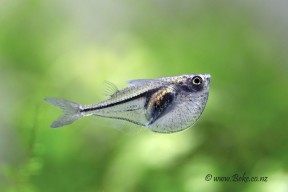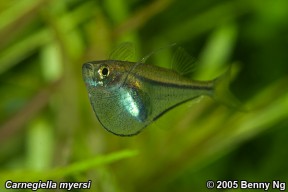Carnegiella myersi
Pygmy Hatchetfish
Etymology
Carnegiella: erected in 1909 by C.H. Eigenmann for the type species C. strigata (which was at that time named Gasteropelecus strigatus); the name honours Miss Margaret Carnegie and was chosen to represent the gracefulness of these fish.
myersi: named in honour of Dr. George S. Meyers, the American ichthyologist who did considerable early work in this genus.
Classification
Order: Characiformes Family: Gasteropelecidae
Distribution
Peruvian Amazon basin; the type locality is a creek near Yurimaguas, Peru. A second population is known from Bolivia, which according to Gery (1977) is deeper bodied that the Peruvian Amazon population.
Habitat
Found in small, shaded and shallow woodland streams in the forest.
Maximum Standard Length
20 – 25 mm.
Aquarium SizeTop ↑
An aquarium with a surface area measuring at least 50 ∗ 30 cm is required.
Maintenance
This species requires a well-matured aquarium with floating plants but providing some clear surface for swimming. Water movement should be minimal so the fish can easily remain motionless in still water. Lighting should not be bright. The top must be well covered; like all hatchetfish in the genus, this one will readily jump whether through play or interaction within the group, fright from other fish below, or if disturbed even by sliding the cover open for feeding.
Driftwood branches and dried leaf litter can also be added, the latter in particular driving establishment of microbe colonies as decomposition occurs.
Such micro-organisms can provide a valuable secondary food source for fry, whilst the tannins and other chemicals released by the decaying leaves are also thought beneficial.
Water Conditions
Temperature: 23 – 26 °C
pH: 4.0 – 7.0
Hardness: 18 – 108 ppm
Diet
Insectivore by nature, eating small insects on the water surface, it will usually accept most prepared foods that float such as flake and micro pellet, small dried insects and bloodworms. Wingless fruit flies are ideal as a live treat.
Behaviour and CompatibilityTop ↑
Very peaceful but due to its small size and rather timid nature it is not a fish for the general community tank. In a community it’s best kept with similarly-sized, peaceful characids and smaller callichthyid or loricariid catfishes; should not have active tankmates. This species will co-habit with the others in the genus.
Must be maintained in a group; six should be the minimum with more if possible.
Sexual Dimorphism
Presumably females will be rounder especially when viewed from above.
Reproduction
Not recorded.
NotesTop ↑
The smallest and most delicate of the nominal hatchetfishes. The rounded keel is shallower than related species, giving this fish a distinctive elongate profile.
The family Gasteropelecidae is separated from other Characiformes by the following combination of characters: frontal bone longitudinally corrugated with a strong longitudinal ridge; posttemporal and supracleithrum fused into a single bone; pelvic fins and associated bones minute; presence of an enlarged, strongly convex muscular pectoral girdle region, consisting of greatly expanded coracoids fused to a single fan-shaped and corrugated median bone; lateral line extending ventro-posteriorly to approach the anal-fin insertion; 0-2 or 3 scales behind head and one or very few scales on caudal-fin base; 10-17 dorsal-fin rays; 22-44 anal-fin rays; adipose-fin present in larger species (those in Gasteropelecus and Thoracocharax), absent in smaller species (those in Carnegiella).
There are currently three valid genera of which Carnegiella is the most speciose with four recognized and described species. Piggott, et al. (2011) suggests there may be more actual species within C. marthae. The species in Carnegiella are the smallest of the hatchetfishes, and all show geographic variations according to the locality. The subject species, along with C. marthae and C. schereri, are basic silver with varying darker dots, dashes or lines across the keel. The Marble Hatchetfish, C. strigata is the fourth described species in the genus. Gery (1977) noted that the species in this genus are polytypic, meaning that within each species there are two or more distinct populations that can be recognized. The Bolivian form of the subject species is deeper bodied than the form from the Peruvian Amazon, for example.
Gasteropelecids are commonly-referred to as ‘freshwater hatchetfishes’ due to their heavily-keeled body shape which has evolved in such a way due to possessing an enlarged, heavily-muscled pectoral girdle, and which resembles the shape of a hatchet head.
They are sometimes said to be capable of propelled flight above the water surface by beating their pectoral fins but in fact this is not the case and was disproven by Wiest (1995) who used high speed video photography to demonstrate that the pectoral fins are used in leaving the water but not while the fish is in the air. The action is more accurately described as a powerful jump and is actually a modified threat response which only appears to be used in extreme circumstances much like in many other fishes.
The researcher also found that the fish only seem to be able to jump once or twice before requiring a rest period due to the large amount of energy required to work the massive pectoral girdle muscles, and when fatigued their threat response is comparable to that of other small species in that they dive towards the substrate.
In addition anecdotal evidence from fish collectors and icthyologists working in the field would suggest that gasteropelecids rarely jump and they also tend not to do so in aquaria, even when being chased with a net (pers. obv.). However, leaving the tank cover open during darkness is likely to result in one or more hatchetfish on the floor by morning, so clearly they do jump.
Characiformes is among the most diverse orders of freshwater fishes currently including close to 2000 valid species distributed among 19 families.
This tremendous taxonomical and morphological diversity has historically impaired the ability of researchers to resolve their genetic relationships with many genera remaining incertae sedis.
A further limiting factor has been that in many cases exhaustive study of these on an individual basis is the only way to resolve such problems.
Modern molecular phylogenetic techniques have allowed some headway, though, and research papers by Javonillo et al. and Oliveira et al., published in 2010 and 2011, respectively, revealed some interesting hypotheses.
The results of the former suggest that Gasteropelecidae forms a monophyletic clade nested within the family Characidae, while the latter expanded on this and concluded that within the family Carnegiella is the sister group of Gasteropelecus with Thoracocharax sister to that clade, and that Gasteropelecidae appears most closely-related to the authors’ expanded Bryconidae which contains the genera Brycon, Henochilus andSalminus.
Others such as Oliveira et al. (2011) have concluded that the family Erythrinidae is also closely-related to this grouping with Hepsetidae and Alestidae more distant.
References
- Fernández-Yépez, A., 1950 - Stanford Ichthyological Bulletin 3(4): 169-181
A revision of the South American characid fishes of the genus Carnegiella. - Gery, J., 1977 - T. F. H. Publications, Inc.: 1-672
Characoids of the World. - Javonillo, R., L. R. Malabarba, S. H. Weitzman and J. R. Burns, 2010 - Molecular Phylogenetics and Evolution 54(2): 498-511
Relationships among major lineages of characid fishes (Teleostei: Ostariophysi: Characiformes), based on molecular sequence data. - Oliveira, O., G. S Avelino, K. T. Abe, T. C Mariguela, R.C Benine, G. Ortí, R. P. Vari and R. M. Corrêa e Castro, 2011 - BMC Evolutionary Biology 11:: 275-300
Phylogenetic relationships within the speciose family Characidae (Teleostei: Ostariophysi: Characiformes) based on multilocus analysis and extensive ingroup sampling. - Piggott, M. P., N. L. Chao and L. B. Beheregaray, 2011 - Biological Journal of the Linnean Society 102(2): 391-403
Three fishes in one: cryptic species in an Amazonian floodplain forest specialist. - Wiest, F.C., 1995 - Journal of Zoology 236(4): 571-592
The specialized locomotory apparatus of the freshwater hatchetfish family Gasteropelecidae.





